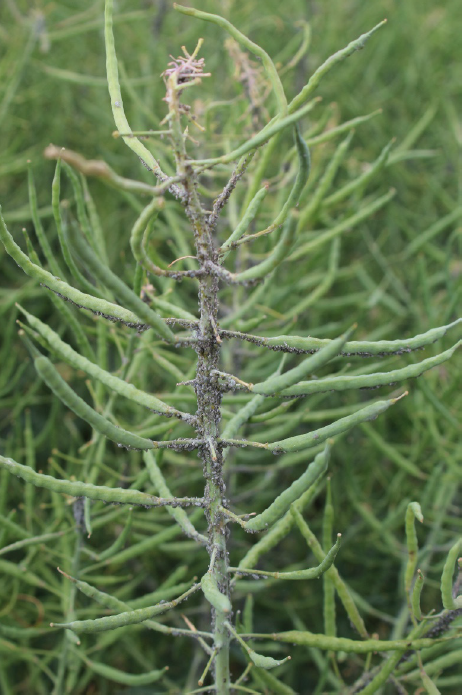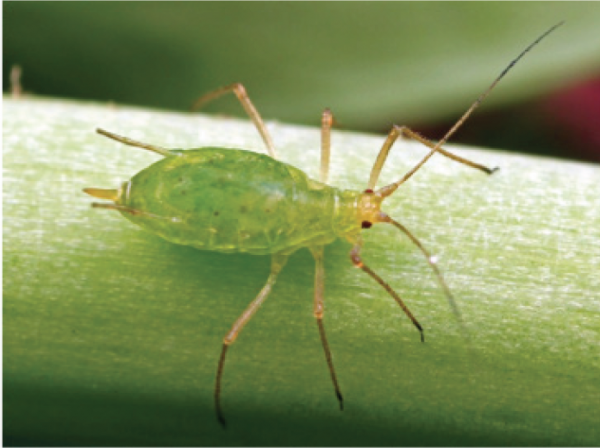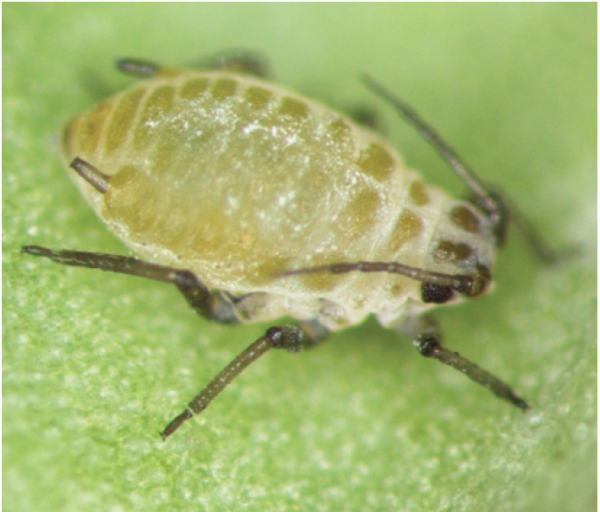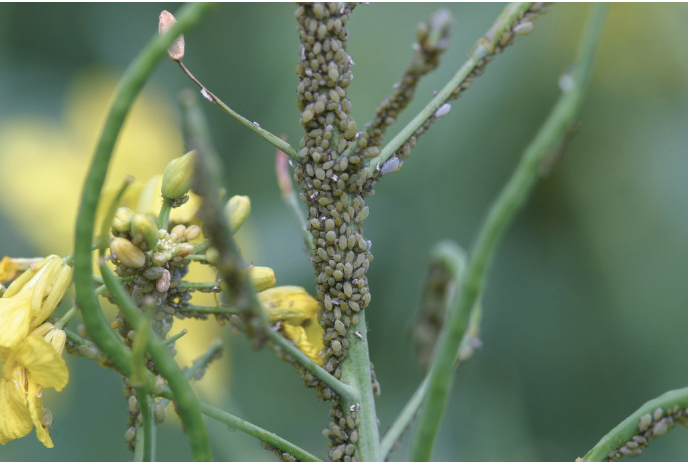Aphids in Winter Canola and Their Management
Aphids are the most economically important insect pests of winter canola in Oklahoma. They occur from crop emergence through pod fill, but the unpredictable climate in Oklahoma makes it difficult to forecast damage. Aphids affect canola yield directly and indirectly. They remove vital fluids that the plant needs to grow and produce seed. They can also serve as a vector of plant viruses such as the one that causes cauliflower mosaic disease.
The decision to control aphids in canola with insecticides requires careful consideration
of profit margins, control costs and yield potential on a field-by-field basis. Climate,
planting times, canola varieties and production practices can affect aphid abundance.
A well-planned Integrated Pest Management (IPM) program gives a producer flexibility
to make economically and environmentally sound control decisions.
Identification, Biology and Nature of Damage
For identification purposes, only the wingless forms of these aphids are described.
Winged forms migrate to new fields, but most scouts encounter the wingless forms.
Wingless aphids are female and give birth to live young (also female) through a process
known as parthenogenesis. This allows them to increase in numbers rapidly. An aphid
life cycle ranges from 16 to 50 days, depending on temperature. An aphid nymph will
molt (shed its skin) four times before becoming an adult. Aphids become adults within
10 to 16 days after birth. Winged and wingless aphids may be present at the same time.
Cabbage aphid (CA) is a soft-bodied, gray-green insect with short cornicles (Figure
1). They measure 2.0 to 2.5 mm and produce a waxy covering on the body. Cabbage aphids
are active throughout the canola season and they typically form dense colonies. In
winter, they occur in rosette plants and after canola plants bolt, they often cluster
on the developing panicle and flowers (Figure 2).

Figure 1. Cabbage aphid adult and nymphs (Photo by Richard Grantham)

Figure 2. Cabbage aphid on canola (Photo by Tom A. Royer)
Wingless forms are more common, but winged aphids are a main source of new infestations when they migrate. They can stunt plants but more frequently cause flower abortion and distortion of pod growth.
Green peach aphid (GPA) measures 1.6 to 2.4 mm long (Figure 3). Its body color ranges
from yellow to green (and sometimes pink). Nymphs are smaller and similar in shape
and color, but have three dark lines on the abdomen. All stages have frontal tubercles
(on the front of the head at the antennal bases).

Figure 3. Green peach aphid
Green peach aphids occur in winter and spring and are found underneath leaves throughout the canola plant (Figure 4). Their feeding can cause stunting, defoliation and can stop terminal growth. They can also transmit plant viruses such as cauliflower mosaic and turnip mosaic virus.
Turnip aphid (TA) Turnip aphids are often mistaken for cabbage aphids, but do not
produce the waxy covering over their body. They are gray-green with short swollen
cornicles, and measure 1.6 to 2.2 mm (Figure 5). Wingless nymphs resemble adults,
but are smaller. One female can produce from 50 to 100 nymphs.

Figure 4. Green peach aphid on canola (Photo by Heath Sanders)

Figure 5. Turnip aphids on panicle (Photo by Tom A. Royer).
Turnip aphids will infest canola throughout the year, but are of particular concern during the winter, when they can increase unnoticed underneath prostrate rosette plants. Their feeding can cause foliage to curl and wilt and plants may become stunted and die. Turnip aphids also feed on panicles and seedpods in spring (Figure 5).
Integrated Control of Canola Aphids
Natural Control
Aphids have numerous natural enemies including several species of parasitic wasps that lay eggs inside the body of the aphid. The parasitic wasp, Diaeretiella rapae, is an important natural enemy of all canola aphids. The aphid swells and turns tan as the immature wasp feeds inside. This dead tan aphid is termed a mummy and remains attached to the canola plant.
Canola aphids have other natural enemies, such as lady beetles, lacewing larvae and hover fly larvae. However, cabbage aphid, and to a lesser extent, turnip aphids, may contain toxins that make them less palatable to some predators, reducing their effectiveness as natural controls.
Cultural Control
The first step in a well-designed IPM program is optimal variety selection. Select varieties based upon production objective, pest problems and compatibility with local soil and climate. Provide the crop with adequate soil fertility to ensure optimum plant development and growth. The control of volunteer plants and weed hosts between harvest and planting may reduce the risk of an early infestation. Some research suggests reduced tillage systems that leave plant residue on the soil surface may reduce aphid colonization.
Sampling and Decision Making for Chemical Control
Field scouting, or pest monitoring, is a cornerstone of any effective IPM program. A good scouting program starts with correct identification of the pests, followed by collecting an accurate, unbiased count of the insects present. Field scouting is a way to take a good “picture” of pests in the field, so collect samples randomly that represent the entire field.
Scout for aphids by looking on the underside of the leaves and panicles. Look underneath
lower leaves of rosette stage canola and on the leaves and racemes of bolted plants.
A sample set should consist of three consecutive plants at each of seven locations
(21 plants total). One sample set should represent no more than 160 acres, so if the
field is larger than a section (160 acres), divide the field into one-section blocks
and take additional samples. Use a “W” or “U” shaped pattern, and combine patterns
for irregularly shaped fields (Figure 6).
Figure 6. Patterns for taking samples.
Treatment Thresholds
Cabbage/Turnip aphids:
Although no research-based thresholds have yet been determined, treatment is suggested if 20 percent of the racemes are infested during bud to early bloom.
Green peach aphids and Turnip aphids:
An ECONOMIC INJURY LEVEL (EIL) is the smallest number of insects that will cause yield loss equal to the cost of management.
An ECONOMIC THRESHOLD (ET) is the pest density at which management action should be taken to prevent an increasing
pest population from reaching the ECONOMIC INJURY LEVEL.
Research conducted at OSU showed that an average of one turnip aphid or green peach
aphid per plant reduces seed yield by about 0.5 pound per acre. Thus, if the value
of the crop (price of canola seed) and the cost of the control (application cost of
an insecticide) is known, an ECONOMIC THRESHOLD can be calculated.
Example: If the cost of an application is $10 per acre, and canola is bringing $0.2 per pound (quote from ADM Farmer Services 04/08/2016 www.adm.com), an infestation of 100 aphids per plant would cause yield loss of $10.00 per acre (100 aphids per plant x 0.5 pounds per acre x $0.2 per pound), which is equal to the cost of the application. The ECONOMIC THRESHOLD (ET) is typically set below the EIL to provide time to schedule the control action and prevent an increasing aphid population from reaching the EIL, in this case at 80 percent of the EIL (80 aphids per plant).
Below is an example of a set of suggested ECONOMIC THRESHOLDS, based on the $10 per acre cost of the application and a price of $0.2 per pound
of seed (Application cost of 0.5 pound per aphid x $0.2 per pound of seed).
Application Economic Injury Economic
Cost Level Threshold
$8.00 per acre 80 aphids per plant 64 aphids per plant
$10.00 per acre 100 aphids per plant 80 aphids per plant
$12.00 per acre 120 aphids per plant 98 aphids per plant
$14.00 per acre 140 aphids per plant 112 aphids per plant
Chemical Control
Insecticides play an important role in an integrated control program. The decision to use insecticides and the selection of them are critical in designing a successful chemical control program. Research has shown that use of a seed treatment of imidacloprid, clothianidin or thiamethoxam is essential to delay fall/winter infestations of aphid build up until February or March.
For foliar applications, select the insecticide based on its effectiveness, potential
impact on beneficial insects and pollinators, potential environmental hazard and residual
activity. Growing conditions influence the amount of injury inflicted by aphids and
the level of control expected from an insecticide application. Generally, dry conditions
increase injury from aphid feeding and decrease effectiveness of an insecticide.
General guidelines for pesticide applications include:
- Read the label for guidelines to protect pollinators. Directions may include prohibition to apply a product during bloom, or to apply at a time when pollinators are less likely to be present.
- Apply the insecticide with the proper amount of carrier (at least 10 gallons per acre by ground, and 2 gallons per acre by air).
- Check the label for restrictions on minimum temperature for application. Some insecticides are less effective in cold weather, while others are more effective.
- Don’t spray if wind velocity exceeds 8 to 10 mph.
- Under adverse conditions, the addition of a surfactant may enhance coverage.
Specific Insecticide recommendations are available in Extension Current Report CR-7667, Management of Insects and Mites on Canola.
Tom A. Royer
Extension Entomologist
Kristopher L. Giles
Research Entomologist

